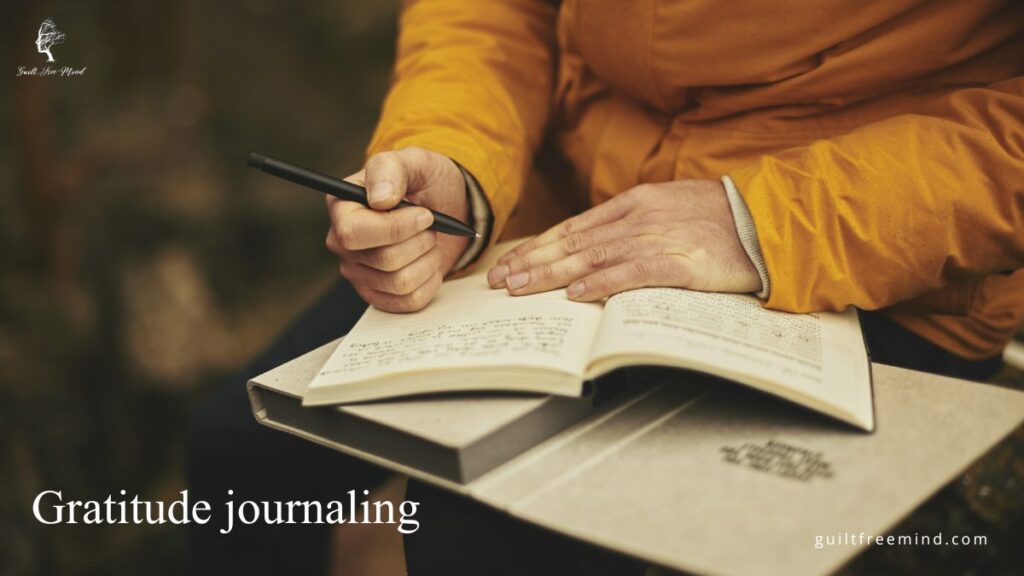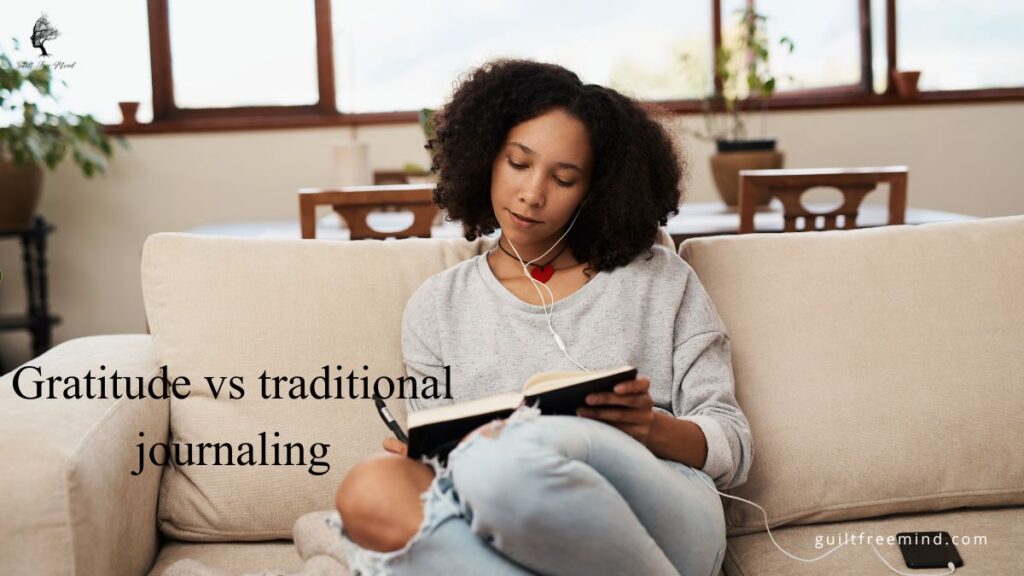What would your answer be if someone asks you what are you happy about right now? Sudden questions can be difficult to deal with. But you should know what you are happy about. Right? Can you recall 5 happy moments since today morning? Unfortunately, this can be very difficult to do at a moment’s notice. Reflecting regularly about what makes you happy can make your life easier and happier. All you need is to give a few moments from your every day and start journaling for gratitude.
Gratitude journaling is very different from traditional journaling practices. In traditional journaling, you write whatever comes to your mind. However, when you engage in gratitude journaling, you with down things or aspects of your life that made you happy or brought you joy. These can be big or small things. As long as they make you happy, they belong in your gratitude journal.

Practising gratitude and journaling for gratitude regularly will allow you to be in a positive mood, and you will feel ready to deal with whatever circumstances life throws towards you. With regular journaling for gratitude, you will stop replaying all of life’s problems in your head. Instead, you will focus on the good things and learn to control your mind.
Do you wish to know more about how to lead a life full of positivity and gratitude? Then subscribe to Guilt Free Mind. I release one article every week. The articles focus on boosting productivity, helping you deal with various mental health issues and leading a happier and more fulfilling life. The subscription option is present in the sidebar. If you like watching videos, please subscribe to the YouTube channel of Guilt Free Mind. Do not forget to ring the notification bell.
Table of Contents
What is journaling for gratitude?
Journaling for gratitude is when you record the things you are grateful for in your journal. You can either start journaling on a piece of paper, on your phone or on a file on your computer. You can use any type of journal you want.
Funding a gratitude journaling method you can be satisfied with is very crucial. Gratitude journaling is not something that you do once a week or once a month. Journaling for gratitude will only take effect if you keep doing it for over a period of 2 months. It takes 2 months to turn regular exercise into a habit. Being grateful is crucial. It can help you prevent diseases and live longer.
Science-backed benefits of practising journaling:
- Reduces the risk of health issues like diabetes and other lifestyle-induced diseases.
- Strengthens your immune system
- Strengthens your memory and reduces the mental decline associated with ageing.
- Boost the quality of your sleep and reduces insomnia.
- Chronic pain issues reduce
- Reduces inflammation in the body.
- Boost your mood and reduces the chances of occurrence of anxiety and depression.
- Increases your self-confidence, and reduces feelings of envy and jealousy.
- Enhances your ability to care for others and yourself.
- Allows you to manage and prioritize your time.
Gratitude journaling vs traditional journaling
When you engage in journaling for gratitude, you focus on cultivating your sense of thankfulness which allows you to appreciate the little things in life. Gratitude journaling involves regularly writing down everything you feel gratitude for. This can include experiences, people, possessions or any other thing that occurred that brought you joy and happiness.
The purpose of journaling for gratitude is to boost your overall sense of well-being and happiness. This in turn books your overall sense of gratitude and positivity.

Traditional journaling is a method of self-reflection. This self-reflection encompasses various emotions and topics. When you write in your journal, you not only express the things that you are grateful for, but you also vent out all your frustration, write down the difficulties you are facing in life and process your tough experiences. The purpose of traditional journaling is to boost your self-awareness. It also helps you work through different personal challenges.
Structure: journaling for gratitude vs traditional journaling
Gratitude journaling follows a defined structure and pattern, unlike traditional journaling which has no specific structure. When journaling for gratitude, you write down the aspects or things in your life you feel grateful for. You are allowed to use prompts or writing guidelines to start writing your gratitude journal if you are finding it hard to write down things you are thankful for
On the other hand, traditional journals are completely unstructured. They have no form or pattern of writing. You just put the date and time and start jotting down your thoughts. You can start writing without a specific prompt in your head. However, if you are looking for prompts for journaling I have covered them in one of my previous blog posts.
Journaling for gratitude: differences in expression
How I write is not how you will write. Some people will express their gratitude in detail while others will finish it in a few lines. Some people will focus on a specific gratitude quote. There is no right or wrong method for this. The primary factor to be taken into consideration is that you must pick a schedule that works best per your lifestyle.
Why should you start gratitude journaling?
There are many benefits to engaging in journaling for gratitude. As per the data of research from Michael McCullough and Robert Emmons, there are many benefits to engaging in the act of journaling for gratitude:
- A boost in personal happiness
- Improved connection with others
- Better deep gratitude
- Better exercise schedule.
- Reduced signs of physical pain.
How does gratitude journaling help?
Expressing gratitude works at a subconscious level. It can help counterbalance the negativity bias that we all have. You must have had an experience where someone appreciates a good quality in you. However, you forget the praise in some time. However, if someone makes a rude remark against you, you remember it much longer.
Focusing on negative issues and criticizing ourselves is an easy task. Focusing on good things and appreciating the good stuff is difficult. However, when you start focusing on the good things, you truly start to realise how much work you have put in, and how less you have appreciated your own efforts.

One way to retire the negative thinking process is to constantly provide stimulus to your brain. The easiest way to do this is to write down your thoughts. This is why positive affirmations and gratitude journaling are favoured by psychologists. When you write down your thoughts, you become more aware of the deeper thoughts which have a greater emotional impact.
Research has shown that participants who experience regular gratitude reported having better sleep at night. They spend less time staying awake while falling asleep and they have also reported feeling more relaxed, energised and fresh when they wake up.
Gratitude journaling has the potential to positively impact various areas of one’s life like adaptability to change, increased satisfaction and better conflict mediation.
In 2017, a study was conducted on 21 Turkish university students to check the effects of gratitude journaling. Eleven students were asked to practice gratitude, and 10 were not. Within a period of 3 weeks, it was observed that the students who indulged in journaling for gratitude showed a higher level of gratitude, a more adjusted university life and an improved life satisfaction quotient.
A similar study was conducted in Australia on group leaders. The results showed that engaging in gratitude journaling allowed the leaders to have a better balance between the positive and negative events of the day. The leaders showed more signs of optimism hope and happiness.
How to start journaling for gratitude?
The first thing you must remember is that there is no right or wrong way of doing this activity. Your first priority should be finding some time of the day when you will have time for yourself without any distractions. If you do not have a lot of time, you can use a bullet journal for gratitude. If you want to do self-exploration, then keep the time off once a week for that.
Next, you must decide when you wish to journal during the day, do you want to do it in the morning or right before going to sleep at night? This schedule must stay constant over time. Following this, you must decide where to write. Will you use pen and paper for this? Will you make the note on your phone? Do you wish to buy a fancy planner for this? These are the first things you must decide.
Following this, you must try out various approaches and see what works best for you. Remember, you don’t have to write down everything that you are grateful for. This can become extremely overwhelming. Writing down 3 to 5 points about what you are thankful for is the best option for starting.

What to be grateful for?
You must remember that you are allowed to be grateful for the same opportunities, things or people on multiple days. For example, you can be grateful for the love and companionship of your loved ones for more than one day. However, try not to make it a mantra for everyday use.
Some points can stay the same. However, some points must change. In case, you notice that you are being grateful for the presence of someone special in your life, make sure to let them know.
Try to figure out what specific thing you are grateful for. Try and write why you are grateful instead of just saying that you are grateful for this person’s presence.
Prompts for getting started on gratitude journaling
Many times we get stuck on how to start writing or expressing gratitude. During such situations, prompts can be very handy. They can get you started and then you can take over. Here are some prompts that you can use to get started on journaling for gratitude:
- What are the 5 technological advances that you cannot do without and why?
- Write about someone whose presence you are grateful for.
- What are the things that you are looking forward to in future?
- Write down about five of your own character traits you are grateful for.
- Which is your favourite time of the day and why?
- Write about five good things that happened to you today.
- What is it about your current job or career that you love?
- Write down five memories that always make you smile.
- Note down the details of a challenging time in your life. Write down 3 things that were positive despite the difficult situation
- Write about the food items that you love and why are you so grateful for those.
- What are your favourite hobbies and why do you appreciate them so much?
- Which is your favourite holiday and why is it so special?
- Write about ten things in nature that you are thankful for.
- Which day of the week is your favourite and why?

How to make time for gratitude journaling in your busy schedule?
If you already have a busy life, adding the task of journaling for gratitude may seem like a lot of unnecessary and added work. However, gratitude journaling can be done at any time of the day It does not have to be time-consuming and can instead help you focus on the positive aspects of your life.
You can surely spare five mins from your daily time to write down 5 things you are grateful for. If you are still confused as to when you should journal, here are some time slots during the day when most people are free:
Right after waking up
You can finish gratitude journaling right after you wake up. Make sure to keep a pen and notebook on the bedside table. Most of us spend a few minutes lounging in bed before we slowly make our way out. This duration of a few minutes is more than enough for you to finish journaling for gratitude for the day.
While waiting for coffee
While you are waiting for your coffee to be ready. Instead of scrolling through YouTube shorts or Instagram reels, use this time to quickly note down five things you are happy or satisfied about.
When you take a break at work.
Now of us can work for all 8 hours in a day we take plenty of breaks in the middle. Use these breaks to finish up your gratitude journaling for the day. It won’t even take up 5 minutes of your break time.

While communing
It may not be ideal to use a pen and paper in a moving vehicle. However, if you are making your notes on an electronic medium then you can finish gratitude journaling while travelling to or back from work.
While you are heating up your dinner.
Whether preparing or heating up your food, there will always be times when you have nothing to do. Utilize this time and get down with your journaling for gratitude for the day.
Right before you go to sleep.
Once you are all ready to hit the bed, you can take a few minutes and finish writing your journal. Recounting the positive things in your day will help you sleep better, reduce nightmares and allow you to sleep better.
Conclusion
Gratitude journaling is the best gift you can give your future self. One of the best parts of journaling for gratitude is that there are no rules to follow. It can be 5 points or 50, it doesn’t matter. Your journal is only your own. You can write anything you wish to be thankful for in your journal. You can doodle, add photos, use various colour pens or decorate it however you wish. It is your personal canvas.
If you have any questions about this blog post or any other, feel free to put your queries in the comment section. You can also reach me on any of my social media channels or on Twitch. I do coworking streams on Twitch every day.
If you want to know more about how to lead a positive life, subscribe to Guilt Free Mind. The subscription option is present in the sidebar. If you like watching videos, subscribe to the YouTube channel of Guilt Free Mind. Do not forget to ring the notification bell.
See you in my next blog post.
